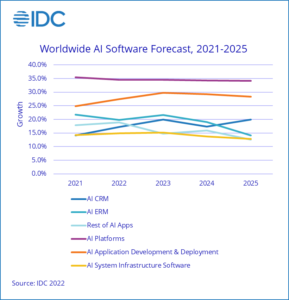Entering 2023, it’s crucial to be prepared not only for all possible challenges but also for the opportunities that companies might create, if they are well aware of the latest tech trends. A great way of doing so is exploring the landscape of the technologies to invest in 2023. This article covers 8 new upcoming technologies to invest in right now, which are good to know for adaptive planning and building comprehensive digital strategies.
The main points to understand about emerging technologies market
When businesses face challenges and crises, they heavily rely on technologies and accelerate its adoption on all levels, to survive and ensure their adaptability, efficiency, and competitiveness. Despite all the issues and black swans of 2022, like post-pandemic adaptation, russian full-scale war in Ukraine, the energy crisis, and rising inflation, IT spending worldwide is projected to total 4.6 trillion U.S. dollars in 2023, an increase of 5.1% since 2022, according to Gartner’s forecast. It’s a golden opportunity for tech companies, with years of experience and domain expertise, to become reliable partners for businesses worldwide and help them deal with concerns and market challenges successfully.
So, what are the new upcoming technologies to invest in right now? In short, expenses to maintain existing on-premises software will last, but the new ones continue to shift to cloud services. Companies will require AI power more, focusing on AI trust, risk, and security management (AI TriSM) framework adoption to deal with critical AI-related issues.
Growing demand for reaching net-zero emissions will drive the transition to sustainable business and technologies in 2023 and beyond. Cybersecurity and data protection will concern business more, following the increase of worldwide threats, and require innovative cybersecurity practices and forcing investments.
Let’s have a look at these technologies in more detail.
Artificial intelligence
Artificial intelligence (AI) solutions have already been adopted across a wide range of industries and have become a competitive advantage and a crucial part of boosting business efficiency. The global AI solutions market is thriving and expected to rise over the coming years, reaching around 126 billion U.S. dollars by 2025, according to Statista.
Among the AI software, hardware, and services solutions categories, the share of the last two will expand faster, with expected AI services compound annual growth rate (CAGR) of 22%, whereas the CAGR for AI hardware will be 20.5%. In the AI software category, AI platforms and AI application development are the leading segments showing a stable trend till 2025.
AI adoption statistics

The key industries that are willing to adopt AI are the following 6:
- High tech and telecom – product/service development and service operations.
- Financial services industry – risk and service operation management.
- Healthcare and pharma – product/service development.
- Business, legal, and professional services – marketing and sales, service operation.
- Automotive and Assembly – manufacturing, marketing, and sales.
- Customer goods and retail – marketing, sales, supply chain management, manufacturing functions.
Services operations optimization has remained the most common use case of AI for majority of industries for years.
Artificial Intelligence is a leading emerging technology with various solutions and services across sectors, and among the best new technologies to invest in, it will continue impacting the IT market, global economy, and society even more intensely based on market forecasts.
Cybersecurity Management and AI TriSM
Scaling and evolving security threats are vital points, with which the tech world has been struggling for years, and, unfortunately, it’s an unfolding trend. Not only mitigation, but prevention of cybersecurity risks, malicious attacks, and other vulnerabilities is the main task for all companies nowadays. Organizations, prioritizing that, could expect additional annual revenue growth, but, those who don’t work on it, will lose customers as digital trust becomes a significantly important decision factor for B2C and B2B clients. They expect total customer data protection, effective cybersecurity measures, trustworthy AI-powered products and services, and transparency in AI and data usage policies from companies.
According to McKinsey’s report, among the executives responsible for risk and technology, most companies still don’t have comprehensive digital risk mitigation strategies and have a lot to work on.

Companies have to react and advance their cybersecurity strategies to become more protected. That’s why the global cybersecurity market is expected to rise from 155.83 billion U.S. dollars in 2022 to 376.32 billion U.S. dollars by 2029, having a CAGR of 13.4%.
AI is one of the emerging technologies in 2023, that the main cybersecurity market players rely on in developing their solutions. But the level of AI-related risks, such as transparency, interpretability, and explainability, remains high, so it drives AI trust, risk, and security management (AI TriSM) adoption.
AI TRiSM
AI TRiSM is a framework supporting AI model governance, fairness, trustworthiness, efficiency, reliability, robustness, and privacy. It includes a set of solutions, techniques and processes for model interpretability and explainability, privacy, model operations and hostile attack resistance for its customers and the enterprise.
What does it take to adopt this emerging trend? Implementation of the AI TRiSM in the project requires a cross-functional team including not just AI engineers, but also legal, compliance, security, and data analytics professionals, but it is worth it, bringing a 50% boost to the AI models results in terms of adoption, business goals, and user acceptance according to Gartner.
Investment in cybersecurity solutions, as well as other solutions helping to mitigate digital risks, is a wise decision for organizations that want to stay competitive in the market and provide high-quality products and services to their customers in 2023 and beyond.
Superapps
Superapps is a technology becoming an essential part of millions of people’s daily lives worldwide. The global superapps market size is going to rise rapidly, with more than 50% of the global population daily active users of even multiple superapps by 2027, as Gartner predicts, having a CAGR of 23.8% through 2028.
Superapp is a platform with single sign-in and access to the mini-apps ecosystem, where each mini-app has its unique function and can be added or removed, by the end user from the main interface, creating a personalized user experience. The current set of functions within apps could vary from shopping, instant messaging, booking venues, tickets, ordering food or taxi, to mobile banking, medical services, etc. In the future, it might amplify to the more advanced options like chatbots, Internet of Things (IoT), or even a metaverse solutions.
To be able to build a handy superapp, it’s crucial to keep the balance between functional diversity and consistency, helping a wide range of the end users with different user scenarios to fulfill their needs seamlessly and delightedly.
Geographically, the market for super apps is more developed in the East, represented by tech giants as WeChat, Alipay, and smaller companies like Grab, Go-Jek, Line, etc. As for the West, the superapps market is less developed, with apps having more limited functions, where Snapchat is the leader of superapps, and Facebook and WhatsApp are also widened their functions to become competitive in the market.
This is the evidence, that superapps market is growing and will gain even more investment and become one of the top upcoming technologies to invest in, bringing more value and the best “all-in-one experience” for the end users.
Read how to estimate the cost of web app development and logistics app development cost in our new article.
Datafication
Data is everywhere. Each of us generates a vast amount of data daily that power companies’ decision-making process. That’s why we are moving towards an even more datafication-focused future.
So, what is datafication?
Datafication is a process of turning previously unmonitored human daily basic activities, currently digitalized, into data that could be properly collected, stored, and transformed by organizations into valuable insights and effective data-driven decisions.
Companies that want to progress fast along the way of becoming real data-driven units within the next few years must work on enhancing the following capabilities:
- Comprehensive data strategy prioritizing data transformational use cases and vetted data experts;
- Cloud-based infrastructure, architectures with real-time analytics and more flexible data store support, versatile database/data-model toolset for unstructured data querying support;
- More powerful edge-computing devices (for example, IoT sensors), advanced-connectivity infrastructures (like 5G), in-memory computing for faster and more effective computations for intensive analytics work;
- Implementation of common data models and using data-sharing platforms to make data collaboration and exchange easier inside and outside organizations;
- Keeping an eye on data security throughout the organization and raising customer awareness about their data-protection rights to keep digital trust.
Data-driven approaches aren’t new emerging technologies, but they ensure continuous performance improvement, create differentiated customer and employee experiences.
All in all, it helps companies be innovative, flexible, and well-prepared for a rising market challenges.
Quantum computing investments
Quantum computing is a disruptive technology that has entered the market lately, and it’s expected to grow from 712.2 million U.S. dollars in 2022 to 4,758.0 million U.S. dollars by 2029, with a CAGR of 31.2% within the forecast period. Despite the huge potential and promising deliverables, it still has some limitations in the wide adoption.
The two main limitations are:
- Undefined “magic number” of quantum volume – the measure of the necessary combined quantity and reliability of the quantum bits (qubits) that drive a quantum computers’ computing capacity and make them useful and effective for solving real-world problems.
- Real-time quantum error correction – qubits are rather delicate and unstable and could break down or decohere, creating a high volume of errors that can quickly overwhelm the quantum computer’s system before it produces reliable results.
Organizations that will try to find handy and scalable solutions to overcome these two challenges, can help the future of quantum computing.
Another direction companies are working on, is the implementation of current quantum computing capabilities in real projects around a wide range of fields:
- Cybersecurity and risk assessment – quantum cyber vulnerability scanning and risk assessment;
- Cryptography – quantum-safe cryptography protocols;
- Air and maritime cargo logistics – implementation of quantum computing algorithms into some optimization applications;
- Quantum chemistry and materials science – the simulation and modeling of molecular, atomic, and subatomic systems;
- Sensors’ creation – highly responsive and accurate quantum sensors have the potential to replace existing sensors used in monitoring applications in many domains, such as oil, gas, mineral deposits industries, construction industry, weather forecasting, seismology.
Where is quantum computing already used?
The quantum computing market will enhance over the next few years due to the deep interest and investment from the top corporations and governments in the United States, Canada, Germany, Netherlands, China, India, Japan, etc. For instance, the US government wants to build a comprehensive ecosystem to accelerate quantum applications discovery, grow and educate a quantum workforce, develop critical infrastructure, standardize cutting-edge R&D.
We can observe this trend or take part and invest in quantum computing among the first.
DevSecOps
DevSecOps is a game-changing practice that significantly transforms cyber and risk management in project development, enabling the delivery of secure systems at pace. Global DevSecOps market size was 2.59 billion U.S. dollars in 2021 and is expected to expand to 23.16 billion U.S. dollars by 2029, having a CAGR of 31.50% during the forecast period of 2022-2029.
DevSecOps service integrates security tools and processes, within the DevOps pipeline, and provides automation of core security tasks, by adding security control from the early stage of the software development lifecycle (SDLC). It also allows constant monitoring and remediation of security defects across the application lifecycle.
Key DevSecOps benefits
- Continuous security – DevSecOps applies the ‘secure by design’ principle by using the automated security code review and application security testing;
- Increased efficiency and product quality – security issues are detected and resolved within development phases, which increases the speed of delivery and augments quality;
- Enhanced compliance – the systems of security, audition, monitoring, and notification are automated and continuously monitored, which facilitates enhanced compliance;
- Increased collaboration – thanks to the integration of development, security, and operations, DevSecOps builds a culture of openness and transparency from the early stage of development.
DevSecOps is here to stay and become the essential part of the responsible and effective project delivery for each tech company. It brings evolution to the software development methodology, improving SDLC and collaboration between development, security, and operations teams, assuring a high level of project automation, risk management, and security. To gain these outcomes, companies will invest in fast DevSecOps adoption within the next few years to fit the new market standard.
Sustainable technology
According to a recent survey of CEOs and senior executives by Gartner, environmental sustainability appears among the top 10 strategic business priorities for them, and it’s a significant shift from 20th place in 2015 to the 8th in 2022. Also, senior executives consider sustainability as a competitive differentiator with the same level of importance as brand trust. Regarding the investment, sustainability of the product is in the 3rd place, after the functional performance and general quality for the 80% of CEOs, seeking green technologies to invest in, as a new opportunity to improve products within 2022 and 2023.
Gartner’s top manager’s research highlights that business sustainability is a must for getting investment and achieving success now, and it will be even more critical in the future. To follow this growing trend, companies have to use technologies and service providers that help them enable sustainable business.
How to invest in green technologies and make a profit?
Cloud sustainability, advanced grid management, and carbon footprint measurement are the three emerging environmental sustainability technologies that will get a wide adoption within the next three years, giving more opportunities to companies. Cloud platforms AWS sustainability, Azure, and Google Cloud are important drivers of sustainable transformation. They provide tools enabling users to build and implement solutions helping their organizations to meet their sustainability goals.

Industry cloud platforms
Speaking of cloud services, they bring even more capabilities and innovative transformations to the vertical industries, such as healthcare, automotive, retail, logistics, media, etc., as part of the industry cloud platforms.
What is industry cloud platform?
Those platforms combine the best technical and business solutions from cloud service providers, software vendors, and integrators to help organizations address their key industry-specific challenges gaining competitive advantage and differentiation.
Cloud services bring even more capabilities and innovative transformations to vertical industries, such as healthcare, automotive, retail, finance, logistics, media, energy, etc. Azure, AWS, and Google.
For example, AWS financial services help banking, payments, and capital markets implement secure, resilient global cloud infrastructures, aligning with financial market regulations and best practices. Industry leaders like Barclays, Coinbase, Nasdaq, Robinhood, Stripe, DBS Bank run their financial services using AWS.
The main benefits of leveraging an industry cloud platform:
- Mature tech solutions providers with deep domain expertise and fast cross-industry innovations adoption;
- Industry-relevant data fabrics architecture;
- A modular approach with composable tooling and often preconfigured capabilities;
- Modernization of the outdated processes and automation of manual tasks.
The level of industry cloud implementation still varies within the market. However, it’s an evolving process thanks to easy access to handy industry-focused solutions helping address niche challenges quickly and offer more capabilities and value to the business.
Read also: What is Cloud Computing, And How Does It Influence the IT Industry?
Crunch predictions for 2023
The technological landscape is changing drastically; that’s the only thing we know for sure. There are technologies and tools riding the hype wave for a couple of years and others that are only gaining momentum. Working on various software development projects so far, we have gained expertise in implementing the most disruptive technologies like AI, ML, security, data science, and cloud computing.
Crunch experts always help clients to navigate changes and choose the most suitable and reliable tech solutions. As for 2023, we predict a dramatic shift to stronger cybersecurity policies and massive cloud adoption. Even though the cloud has already become a buzzword, its power in the shape of industry clouds and substantial modernization sources will only grow. Cybersecurity is another priority for organizations worldwide to not only protect their assets from threat actors, but also scale infrastructures safely.
These aren’t the only technology trends we’ll expect to come in 2023, but our team will gladly assist you with implementation in your projects.
Final thoughts
The good news is that the technology market keeps growing no matter what challenges we face and moving hand in hand with businesses to address their urgent needs and long-term goals effectively. An overview of eight new technologies to invest in 2023 will definitely give you some ideas on how to use them to enhance your business strategy and become more resistant.
Still, if you want more insights and guidelines on how to decide on future technologies to invest in, you can talk to our expert, who will help you make an effective decision according to your needs and project.







![10 Top DevOps KPIs to Track [and no more] - Crunch.is](https://crunch.is/wp-content/uploads/2023/03/03-855x600.png)
